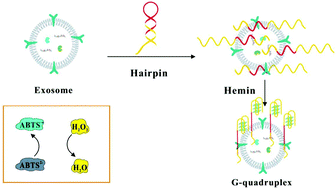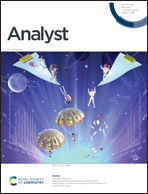Detection of breast cancer-derived exosomes using the horseradish peroxidase-mimicking DNAzyme as an aptasensor†
Abstract
Exosomes are membrane-enclosed phospholipid extracellular vesicles with a variety of tumor antigens which can be applied in the diagnosis and treatment of cancer due to the high secretion on the surface of cancer cells. Until now, many research studies on exosomes have been reported, but convenient and low-cost detection methods still need to be developed. Recently, we have developed a sensitive, simple and low-cost colorimetric aptasensor by designing a hairpin-like structure, which combined the highly specific MUC1 aptamer with a hemin/G-quadruplex for the detection of breast cancer exosomes. The hemin/G-quadruplex toward H2O2 reduction was used to generate an evidently strong colorimetric response owing to acting as a HRP-mimicking DNAzyme. The aptasensor is regarded as an “on–off” type switch, which strictly controls the process of reaction responding to the existence or not of exosomes. In our study, associated exosome detection limits are 3.94 × 105 particles per mL, which showed a higher sensitivity compared to commercial ELISA. Our method not only exhibited the advantages of being convenient and time-saving, with few instruments used, but also the signal generated using this method can be easily observed by the naked eye. Furthermore, the proposed strategy can well differentiate breast cancer patients from healthy individuals, demonstrating potential application in the analysis of clinical specimens.



 Please wait while we load your content...
Please wait while we load your content...